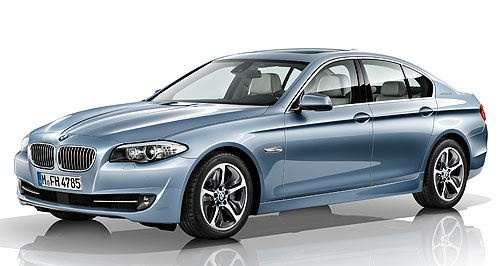Future models - BMW - 5 Series - ActiveHybrid 5Petrol-electric BMW ActiveHybrid 5 on agenda for OzHybrid hope: BMW Australia has its fingers crossed for a right-hand drive 5 Series hybrid. Punchy, thrifty hybrid BMW 5 Series a chance to be sold Down Under30 Sep 2011 BMW has taken the wraps off its petrol-electric 5 Series ActiveHybrid ahead of its global launch next March, and hopes are high that it will come to Australia if it is produced in right-hand drive. The Bavarian brand’s head of corporate communications for Australia and New Zealand, Piers Scott, told GoAuto the frugal Five was “certainly a car we’d like to bring down here”. He said the car was likely to be produced in right-hand drive, unlike previous BMW hybrids – the X6 and 7 Series – in which a 4.4-litre V8 was mated with an electric motor and sold primarily in the United States. “We do think there is demand for a car like this down here, but considerably smaller volumes are likely,” he said. Like its concept namesake that appeared at the 2010 Geneva motor show, the ActiveHybrid 5 employs a 40kW electric motor sandwiched between its 3.0-litre turbocharged straight-six petrol engine (borrowed from the 535i) and the ZF eight-speed automatic transmission. A combined power and torque output of 250kW and 450Nm can haul the sedan from rest to 100km/h in a sporty 5.9 seconds – two tenths quicker than the respectably rapid 535i on which it is based. Even so, it can return combined fuel economy of between 6.4 litres per 100km and 7.0L/100km, with CO2 outputs ranging from 149 grams per kilometre to 163g/km – compared with the 8.4L/100km and 195g/km of the 535i. When compared with the punchy six-cylinder diesel-powered 535d that is not sold in Australia, the hybrid starts to look – on paper – a little less impressive.  Thanks to a sizeable 600Nm of torque, the 535d shaves two tenths off the hybrid’s dash to 100km/h, emits at least 7g/km less CO2 and consumes at least a litre less fuel per hundred kilometres. Thanks to a sizeable 600Nm of torque, the 535d shaves two tenths off the hybrid’s dash to 100km/h, emits at least 7g/km less CO2 and consumes at least a litre less fuel per hundred kilometres.Mr Scott said the hybrid could travel on electricity alone for up to 4km at up to 60km/h, emitting zero tailpipe emissions in some circumstances. He said the car was suitable for markets such as Japan where government incentives were offered on hybrid vehicles, as well as the US. The hybrid BMW can also coast with the engine turned off under deceleration or a trailing throttle at speeds of up to 160km/h. The BMW compares well on paper against the competition from rival Audi and hybrid veteran Lexus. The A6 Hybrid combines a turbocharged petrol four-cylinder engine with an electric motor and therefore can’t compete with the BMW on performance. It produces 180kW – but a BMW-bashing 480Nm – leading to a 7.3 second 0-100km/h time, fuel consumption of 6.2L/100km and CO2 emissions of 146g/km. The Lexus GS450h, with its drivetrain based around 3.5-litre naturally-aspirated V6 to provide a combined output of 252kW and 345Nm, matches the BMW’s 0-100km/h sprint but consumes just a tenth of a litre per kilometre more than the Audi and emits one extra gram of CO2 per kilometre. BMW has developed an intelligent energy management system that works with the standard navigation system to predict changes in driving conditions or driver requirements to ensure the hybrid system works in the most efficient way possible. For example, if the chosen route includes a hilly section, the system can calculate how much electricity can be generated on the descents and employ more electric power to save fuel on the climbs, thereby minimising the unnecessary over-use of internal combustion. In addition, it can ensure the battery is as close to fully charged as possible near the end of the journey, enabling a greater chance of zero-emissions driving for the last few kilometres, which are often likely to be in an urban environment that benefits from reduced local air pollution.  Read more8th of April 2011  Shanghai show: BMW plugs in 5 Series for ChinaBMW-Brilliance joint-venture bears fruit with Chinese LWB 5 Series plug-in hybrid5 Series pricing
Motor industry news |
Click to shareBMW models5 Series pricing
Motor industry news |
















Facebook Twitter Instagram